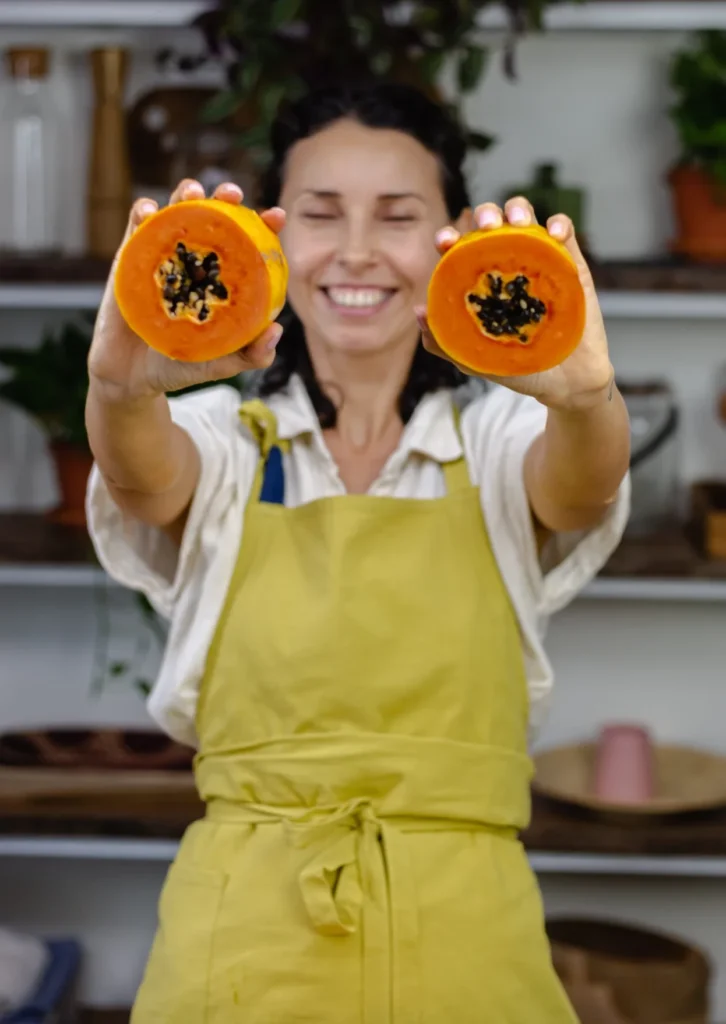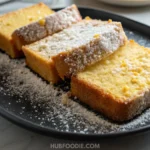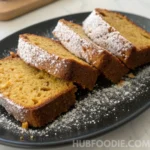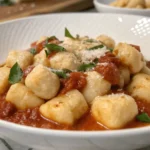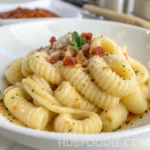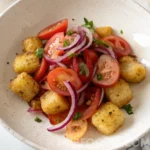Whenever I think of cozy Italian comfort food, I picture a steaming bowl of gnocchi marinara. Those tender little dumplings tossed in rich tomato sauce always feel like a warm hug at the dinner table. For me, it is one of those dishes that never disappoints. It is quick enough for weeknights, yet comforting enough to bring back memories of family gatherings where simple flavors meant everything.
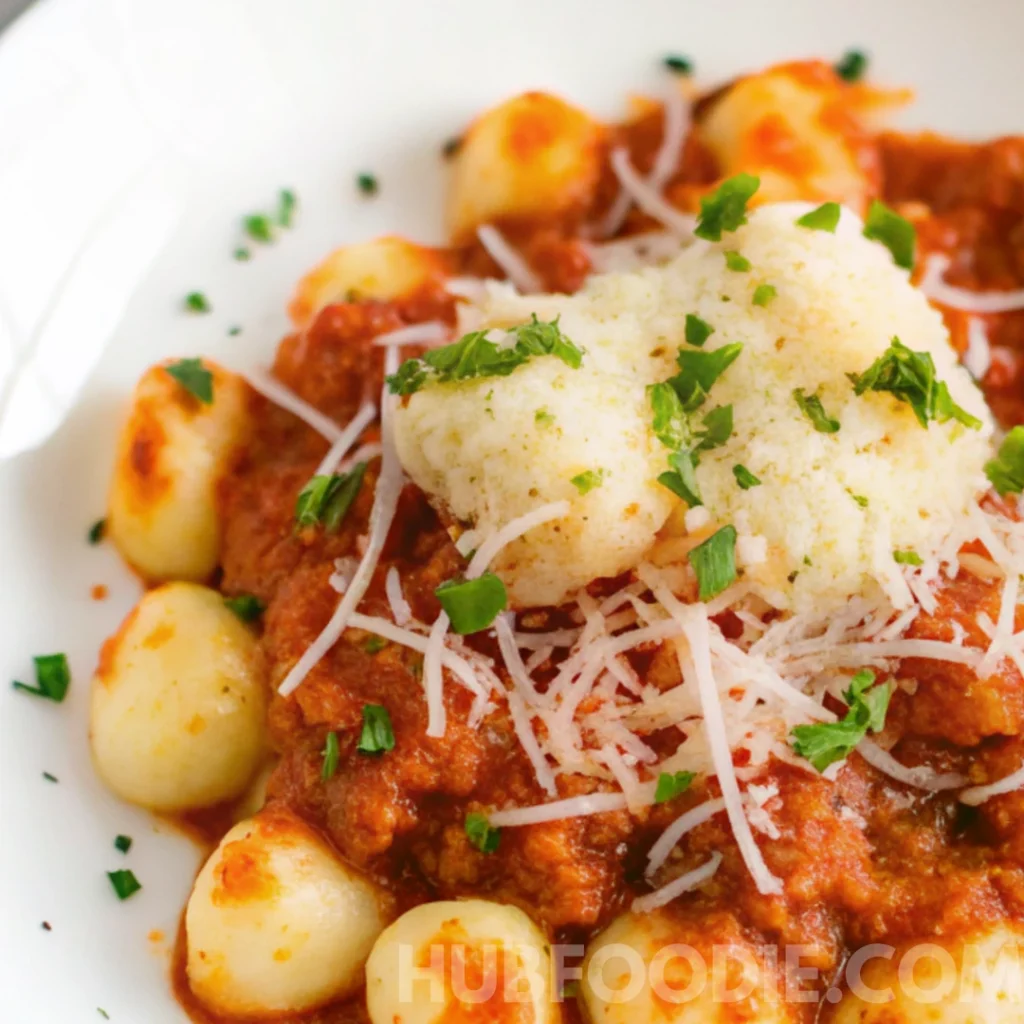
What I love most about this recipe is its flexibility. Sometimes I pan fry gnocchi for crispy edges, other times I bake it under a blanket of mozzarella until it bubbles at the corners. Whether you use classic potato gnocchi, lighter cauliflower gnocchi, or a ricotta version for extra creaminess, marinara brings everything together beautifully. And here is a little secret: once you have tried this recipe, you will probably find yourself craving it on repeat, and that is exactly why I keep it in regular rotation in my kitchen.
(Psst… if you have ever wondered how else to enjoy gnocchi, keep reading. I will share plenty of variations, and you might just discover a new favorite way to cook it.)
Table of Contents
Why Gnocchi Marinara Recipe Works
What makes gnocchi marinara so comforting is the balance between pillowy dumplings and a rich tomato base. The flavors are simple yet layered, which is why this dish has stood the test of time in Italian kitchens and in mine as well. Every forkful tastes like something you would order in a trattoria, but it takes only a fraction of the effort to prepare at home.
I also love how flexible it is. Sometimes I prepare gnocchi with marinara sauce in a skillet for a quick weeknight dinner. Other times, I take a little extra time to bake it with cheese for a family-style casserole. Either way, the result is satisfying and comforting, which makes this recipe one of my most dependable go-to meals.
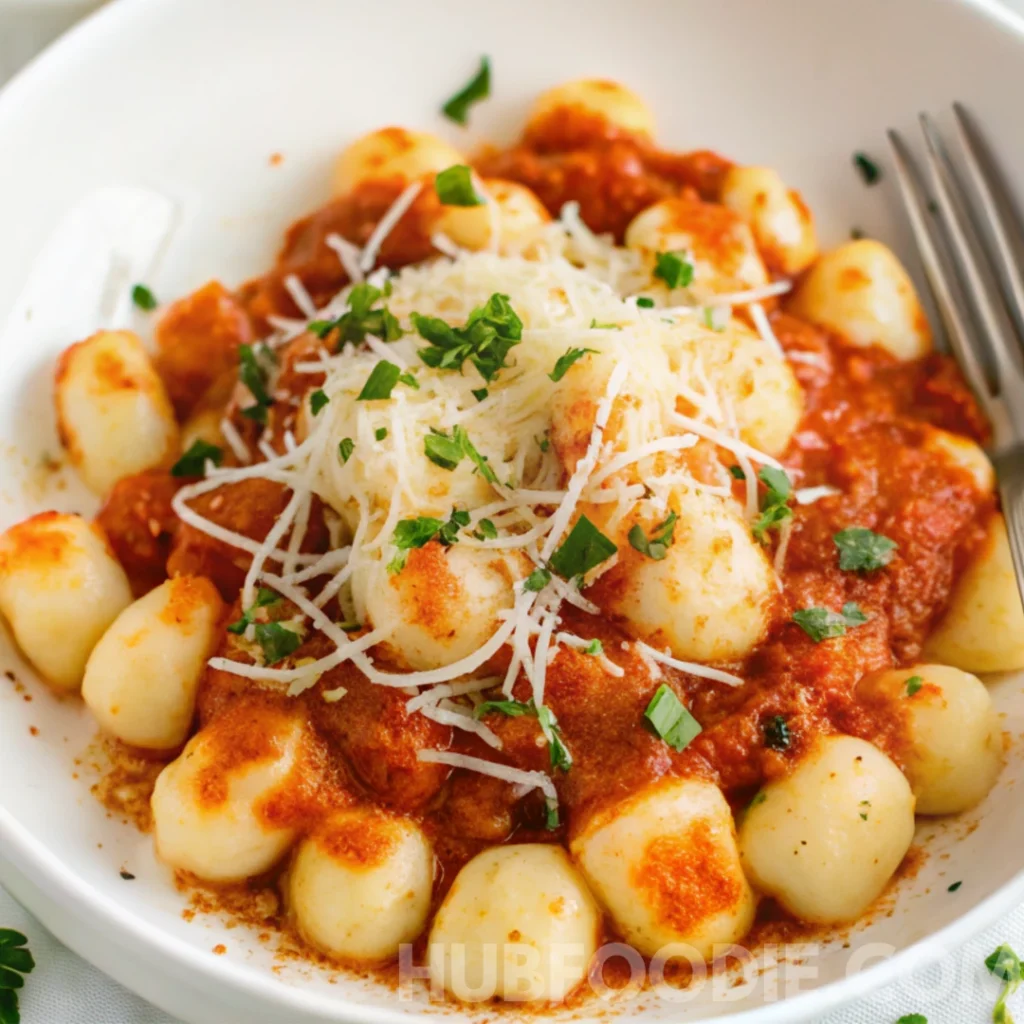
Another reason this recipe works so well is how accessible the ingredients are. Marinara sauce, gnocchi, and a few fresh herbs are all you need to create something that feels special without being complicated. Affordable, adaptable, and endlessly delicious, this is the kind of dish I can make again and again without ever getting tired of it.
Ingredients & Smart Substitutions
The beauty of marinara gnocchi is that it does not take a long list of ingredients to taste incredible. With just a few staples, you can build a dish that feels rustic yet indulgent. Here is what I usually reach for in my kitchen:
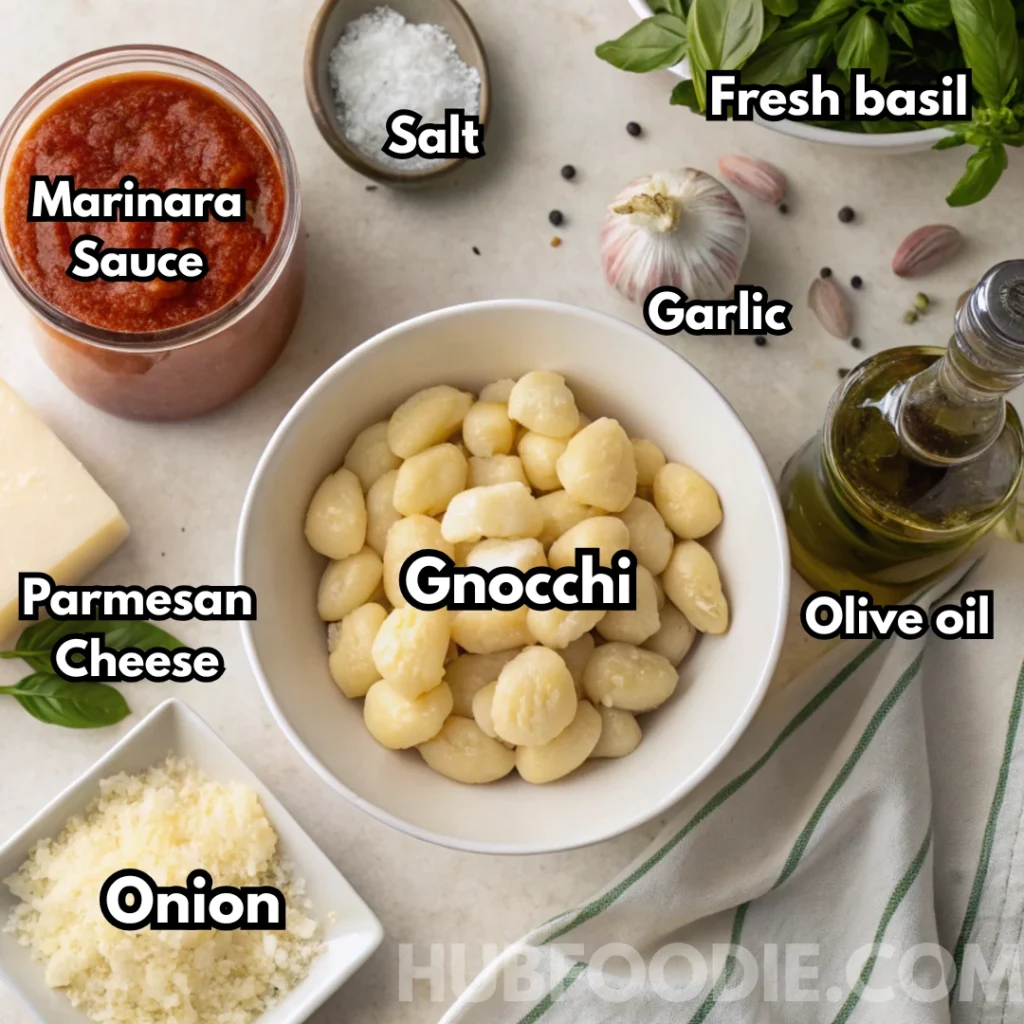
- Gnocchi: Traditional potato gnocchi is my favorite starting point. Its starchy, pillowy texture absorbs sauce perfectly. You can also experiment with ricotta gnocchi or even whole wheat versions for a nuttier bite. If you want to explore other styles, I have shared ideas in my potato gnocchi sauce recipe.
- Marinara Sauce: A good marinara sauce for gnocchi should strike the right balance between acidity and sweetness. You can use a high quality jarred brand when short on time, or prepare a homemade version with crushed tomatoes, garlic, onions, and olive oil. Fresh basil at the end brightens the sauce beautifully.
- Garlic and Onion: These aromatics build the foundation of flavor. Even a quick sauté makes a big difference.
- Olive Oil: Use a good extra virgin olive oil for sautéing and finishing.
- Parmesan Cheese: Adds a salty, nutty finish. For a creamier twist, I sometimes fold in ricotta cheese.
- Fresh Basil: Adds color, fragrance, and that unmistakable Italian note.
Substitutions and Variations
- Dairy-free: Skip the parmesan or replace it with nutritional yeast for a cheesy flavor without dairy.
- Vegan: Many store-bought gnocchi are naturally vegan, so simply ensure your marinara is made without cheese.
- Gluten-free: Swap in gluten-free gnocchi made with rice flour or chickpeas.
- Protein boost: Add Italian sausage, chicken, or even shrimp if you want a heartier dish.
What I love most is how forgiving this recipe is. Even with substitutions, the flavors come together in a way that always feels complete. Once you find your favorite version, it quickly becomes a staple meal worth making again and again.
Gnocchi Marinara Recipe Step-by-Step Cooking Instructions
Making gnocchi marinara at home can be as quick or as comforting as you want it to be. I often start with the stovetop version when I am short on time, and on weekends I prepare a cheesy baked casserole that everyone loves. Here is how I do both:
Stovetop Gnocchi Marinara
Cook the Gnocchi: Bring a large pot of salted water to a boil. Drop in the gnocchi and cook until they float to the top, usually in two to three minutes. Remove them gently with a slotted spoon.

Prepare the Sauce: While the gnocchi cook, warm olive oil in a skillet over medium heat. Add garlic and onion, cooking until softened. Stir in crushed tomatoes, salt, pepper, and fresh basil. Let it simmer gently for about 15 minutes.
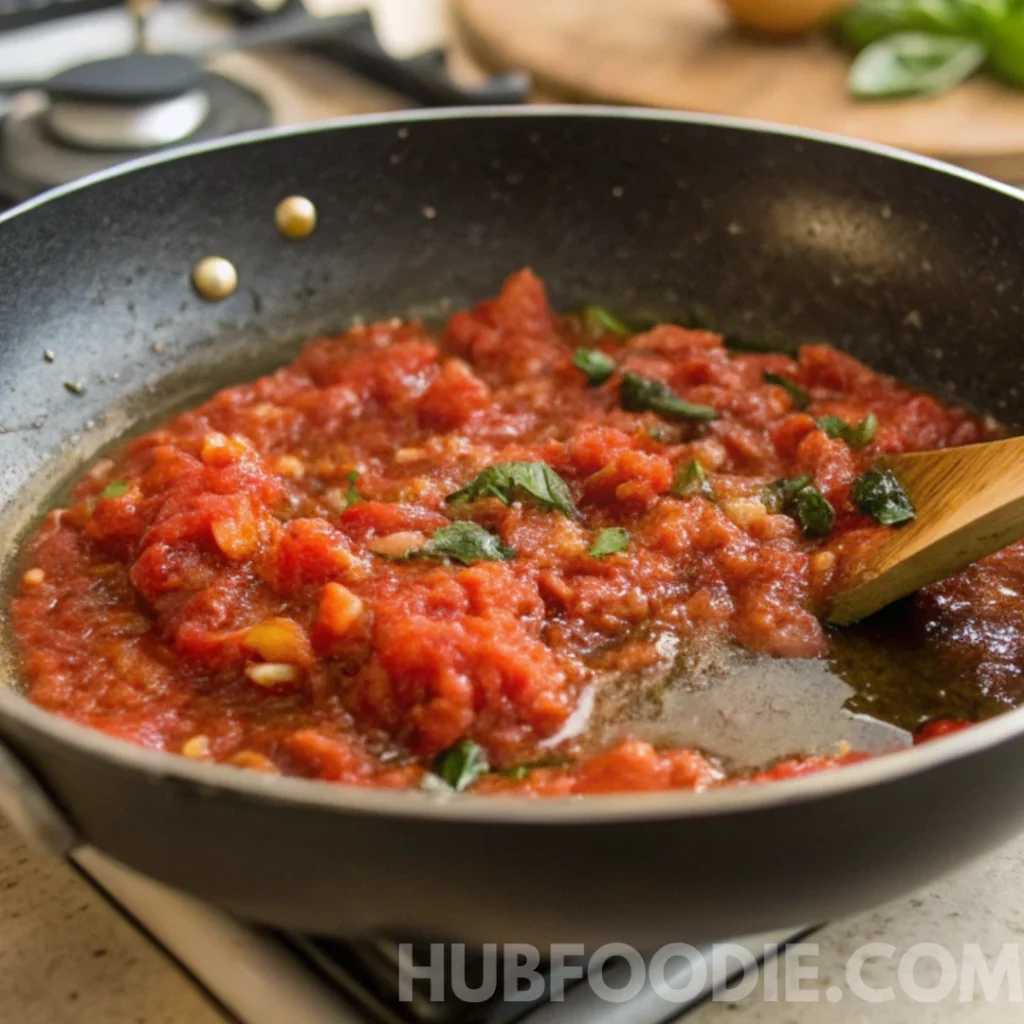
Combine and Serve: Add the cooked gnocchi to the skillet, tossing them in the sauce until well coated. Sprinkle with parmesan cheese and serve hot.
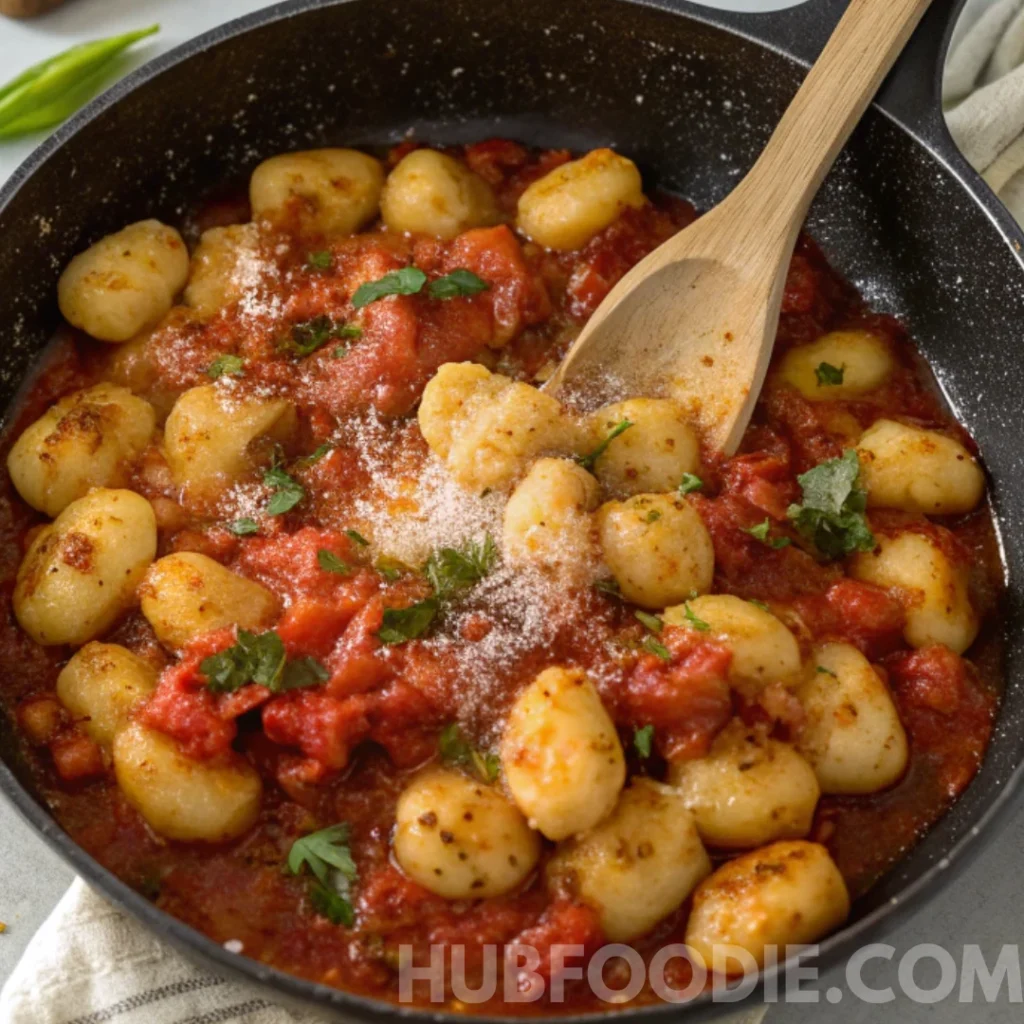
This version is quick, reliable, and perfect for a weeknight dinner. If you love experimenting with texture, you might also enjoy this method I shared in my crispy gnocchi with tomato and red onion recipe.

Baked Gnocchi Variations
When I want something heartier, I make baked gnocchi with marinara sauce. After preparing the gnocchi and marinara as above, I transfer everything into an oven-safe dish. I scatter mozzarella over the top, then bake at 375°F until the cheese is melted and golden at the edges, about 15 minutes. The result is bubbling, cheesy comfort food that feels like a hug in every bite.

For extra richness, I sometimes prepare baked gnocchi with ricotta and marinara. I simply add spoonfuls of ricotta between the gnocchi layers before topping with mozzarella. The ricotta melts into the sauce, giving the dish a creamy, decadent texture. This is a wonderful option when serving guests, because it looks and tastes like something from an Italian restaurant.
Expert Tips, Variations & Pairings
The best part about cooking gnocchi marinara at home is how easy it is to adapt. With a few small changes, you can turn the same base recipe into something new and exciting.
Smart Tips for Cooking Gnocchi
- Do not overcook the gnocchi. They are ready the moment they float to the top. Any longer and they can turn mushy.
- Always reserve a little pasta water. The starch helps the marinara sauce cling beautifully to the gnocchi.
- If you are baking, cover the dish with foil for the first 10 minutes, then uncover to finish browning the cheese.
Variations You Will Love
- Cauliflower Gnocchi Marinara: This lighter version is a favorite when I want something filling but not too heavy. Cauliflower gnocchi holds its shape well, and the marinara adds enough flavor to make it taste indulgent.
- Spinach and Mushroom Add-In: Toss in fresh spinach or sautéed mushrooms just before combining the gnocchi with sauce for extra nutrition.
- Meat Lovers’ Twist: Add cooked Italian sausage, shredded chicken, or even shrimp for more protein.
- Cheesy Comfort: Try adding different cheeses like fontina or provolone for a creamier baked casserole.
What to Serve with Gnocchi Marinara
One of the reasons I love gnocchi and marinara is how well it pairs with other Italian-inspired sides. A crisp arugula salad with lemon vinaigrette balances the richness. Garlic bread or focaccia is always a welcome addition. And if you are planning a full meal, roasted vegetables like zucchini or eggplant make excellent companions. For more inspiration, I often look back at my ideas for what to eat with gnocchi when building a complete dinner menu.
Another great pairing idea is to explore other Italian sauces that complement gnocchi. If you ever want to branch out, check out my gnocchi and pasta sauce guide for flavor combinations beyond marinara.
Storage, Make-Ahead & Freezer Advice
One of the things I appreciate most about gnocchi marinara is how well it adapts to meal prep. The flavors actually deepen after resting, making it even more satisfying the next day.
Storing Leftovers
Allow the dish to cool completely before transferring it to an airtight container. It will keep in the refrigerator for up to three days. When reheating, I prefer to warm it gently in a skillet with a splash of extra sauce or water. This prevents the gnocchi from drying out.
Make-Ahead Tips
If you want to prepare ahead, assemble the gnocchi and marinara in a baking dish, sprinkle the cheese, and store it covered in the refrigerator for up to 24 hours. When ready to serve, bake it as directed, adding about five extra minutes since the dish will be cold. This method is ideal when entertaining, because you can enjoy time with your guests instead of being stuck in the kitchen.
Freezing for Later
Uncooked gnocchi freeze beautifully. Place them on a baking sheet until solid, then transfer to a container or freezer bag. They will keep for up to two months. Cook them straight from frozen, adding an extra minute to the boiling time. Cooked gnocchi in sauce can be frozen as well, but the texture may soften once reheated. For the best results, freeze them in small portions that can be reheated individually.
If you want more creative ways to reuse leftovers, you might enjoy my ideas for potato gnocchi sauce recipes. It is a great way to refresh a batch of gnocchi and keep meals exciting throughout the week.
FAQ About Gnocchi Marinara
Is marinara sauce good with gnocchi?
Absolutely. The bright acidity of tomatoes balances the soft, starchy texture of gnocchi perfectly. Marinara is one of the most traditional and beloved choices, and it allows the gnocchi to remain the star of the dish.
What kind of sauce goes well with gnocchi?
Beyond marinara, gnocchi pairs beautifully with cream-based sauces, brown butter with sage, or even pesto. If you are curious about exploring other options, I have shared several potato gnocchi sauce ideas that make excellent alternatives.
Does gnocchi work with tomato sauce?
Yes, gnocchi works wonderfully with any tomato-based sauce. The key is simmering the sauce long enough to develop depth and richness so it clings to the dumplings instead of feeling watery.
What do gnocchi pair well with?
Gnocchi goes well with simple sides like leafy salads, garlic bread, or roasted vegetables. In Italy, it is often served as a first course before meat or fish, but at home I find it hearty enough to serve as the main dish.
What do Italians eat with gnocchi?
Traditionally, Italians enjoy gnocchi with sauces that highlight regional ingredients. In Rome, you might find gnocchi alla sorrentina baked with mozzarella and basil. In other regions, it could be paired with meat ragu or simple butter and sage.
Is it better to pan fry or boil gnocchi?
Boiling is the standard method, and it keeps the dumplings soft and tender. Pan frying creates a crispy exterior and chewy center, which is a fun variation. Both methods are delicious, and it depends on the texture you prefer.
Is gnocchi healthy to eat?
Gnocchi can be part of a balanced meal. Potato gnocchi is more calorie-dense than pasta, but portion control and lighter sauces, such as marinara, keep it in check. For a lighter twist, cauliflower gnocchi is lower in carbs and pairs wonderfully with tomato-based sauces.
Do you need sauce with gnocchi?
Not always, but sauce elevates the experience. Even a simple drizzle of olive oil with parmesan tastes great. My personal favorite, though, is gnocchi marinara with fresh ricotta, which creates a creamy, tangy balance that feels like a restaurant-quality dish.
Conclusion & Call to Action
For me, gnocchi marinara is one of those timeless recipes that never loses its charm. It is quick to prepare, endlessly adaptable, and always delivers the kind of comfort that keeps everyone coming back for seconds. Whether you choose a skillet version on a weeknight, a bubbling baked casserole on the weekend, or a lighter variation with cauliflower, there is a version of this dish for every mood and occasion.
I encourage you to try your own twist, whether that means adding fresh vegetables, experimenting with different cheeses, or serving it with a crisp salad on the side. Cooking should always feel approachable, and this recipe proves that a handful of simple ingredients can become something truly memorable. And if you love what you see here, follow me on Facebook and Pinterest for more easy, delicious recipes and daily inspiration that will keep your kitchen full of flavor.
Recipe
Print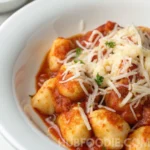
Gnocchi Marinara
- Prep Time: 10 minutes
- Cook Time: 20 minutes
- Total Time: 30 minutes
- Yield: 4 servings
- Category: Lunch or Dinner
- Method: Stovetop or Baked
- Cuisine: Italian
- Diet: Vegetarian
Description
A cozy Italian comfort food made with tender gnocchi tossed in a rich marinara sauce, finished with parmesan and fresh basil. Perfect for weeknights, yet elegant enough to serve to guests.
Ingredients
1 lb potato gnocchi (fresh, frozen, or shelf-stable)
2 cups marinara sauce (homemade or high-quality jarred)
2 tbsp olive oil
2 garlic cloves, minced
1 small onion, finely chopped
½ tsp sea salt
¼ tsp black pepper
½ tsp dried oregano
¼ tsp red pepper flakes (optional)
½ cup parmesan cheese, grated
½ cup mozzarella cheese (for baked version, optional)
½ cup ricotta cheese (for baked ricotta version, optional)
Fresh basil leaves, torn
Instructions
1. Bring a large pot of salted water to a boil. Cook the gnocchi until they float to the top, about 2–3 minutes. Drain and set aside.
2. In a skillet, heat olive oil over medium heat. Add onion and cook until soft, about 5 minutes. Stir in garlic and cook for 30 seconds.
3. Pour in marinara sauce, season with oregano, salt, pepper, and red pepper flakes. Simmer gently for 10–15 minutes.
4. Add the cooked gnocchi to the sauce and toss to coat. Sprinkle with parmesan and basil before serving.
5. For baked gnocchi with marinara sauce: transfer gnocchi and sauce to an oven-safe dish, top with mozzarella, and bake at 375°F for 15 minutes until bubbly.
6. For baked gnocchi with ricotta and marinara: add spoonfuls of ricotta before topping with mozzarella and baking.
Notes
For a lighter option, substitute cauliflower gnocchi.
Use vegan parmesan or nutritional yeast for a dairy-free version.
Freeze uncooked gnocchi on a baking sheet, then transfer to a freezer-safe container for up to 2 months.

